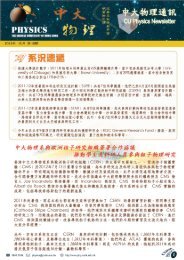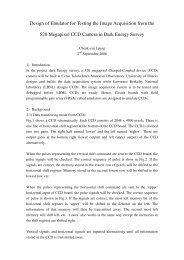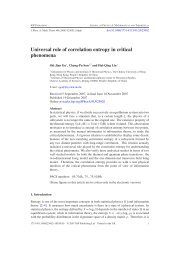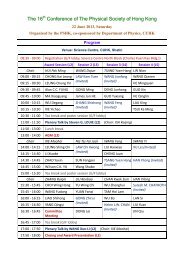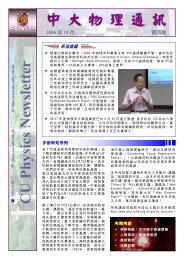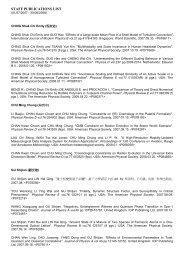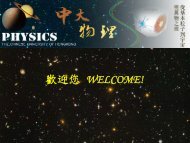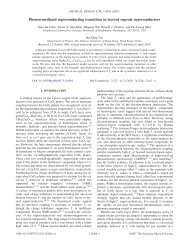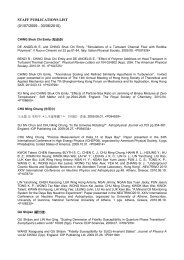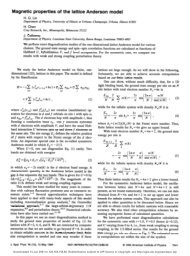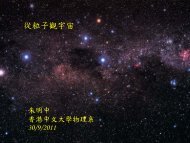et al.
et al.
et al.
You also want an ePaper? Increase the reach of your titles
YUMPU automatically turns print PDFs into web optimized ePapers that Google loves.
How to Empower your Quantum Gas<br />
Tilman Esslinger ETH Zürich<br />
Funding: ETH, EU (ERC, NameQuam, Sc<strong>al</strong>a), QSIT, SNF<br />
www.quantumoptics.<strong>et</strong>hz.ch
Momentum dependent interaction - roton<br />
For dipolar gases: L. Santos, G.V. Shlyapnikov, and M. Lewenstein, PRL 90, 250403 (2003)<br />
Helium
Momentum dependent interaction - roton<br />
For dipolar gases: L. Santos, G.V. Shlyapnikov, and M. Lewenstein, PRL 90, 250403 (2003)
Bose-Einstein condensate<br />
N=150,000 atoms<br />
high-finesse optic<strong>al</strong> cavity<br />
length 178 µm<br />
Finesse 340,000<br />
related experiments: V. Vul<strong>et</strong>ic, D. Stamper-Kurn, J. Reichel, A. Hemmerich, C. Zimmermann
standing-wave pump laser<br />
atomic d<strong>et</strong>uning: far d<strong>et</strong>uned<br />
cavity d<strong>et</strong>uning: near resonant
Phase Transition<br />
K. Baumann <strong>et</strong> <strong>al</strong>., Nature 464, 1301 (2010)<br />
Theory: H. Ritsch, P. Domokos, I. Mekhov Exp. with therm<strong>al</strong> atoms: V. Vul<strong>et</strong>ic
(dynamic<strong>al</strong>)<br />
quantum phase<br />
transition<br />
coupling strength<br />
order param<strong>et</strong>er zero point motion potenti<strong>al</strong> energy<br />
spontaneous symm<strong>et</strong>ry<br />
breaking<br />
even<br />
odd
Cavity-‐mediated atom-‐atom interac0on<br />
(�k,�k)<br />
related: Münstermann <strong>et</strong> <strong>al</strong>. PRL 84, 4068 (2000), J. Asboth at <strong>al</strong>. PRA 70, 013414 (2004)
p z<br />
p x , p z = 0, 0<br />
Two-‐Mode Picture<br />
p x<br />
(�k,�k)<br />
p x , p z<br />
= � ±�k,±�k
Excita0on spectrum – mode soPening<br />
see <strong>al</strong>so: C. Emary <strong>et</strong> <strong>al</strong>. 90, 044101 (2003), D. Nagy <strong>et</strong> <strong>al</strong>. EPJD 48,127 (2008)…
probe beam<br />
Probing the excita0on spectrum<br />
0.5ms<br />
cavity output:<br />
-‐ probe light<br />
-‐ Bragg-‐scaTered light
Probing the excita0on spectrum<br />
probe light<br />
Bragg scaTered<br />
light<br />
R. MoTl, F. Brennecke, K. Baumann, R. Landig, T. Donner, T. Esslinger, arXiv:1203.1322 (to be published in Science)
Excita0on spectrum<br />
norm<strong>al</strong> phase sr. phase<br />
shading: ab-‐ini,o c<strong>al</strong>cula0on including collisions and trapping
Suscep0bility
Quantum Simulator<br />
Quantum Gases ( 40 K)<br />
+<br />
Optic<strong>al</strong> Lattices<br />
See <strong>al</strong>so: Mainz/Munich, Hamburg, MIT,…
Band structures with topologic<strong>al</strong><br />
defects<br />
Topologic<strong>al</strong> defects: Dirac points<br />
Quantum gases in lattices with topologic<strong>al</strong> defects<br />
Excited bands:<br />
• 1D « Dirac point » (Weitz group, Bonn)<br />
S. Kling <strong>et</strong> <strong>al</strong>., Phys. Rev. L<strong>et</strong>t. 105, 215301 (2010)<br />
T. S<strong>al</strong>ger <strong>et</strong> <strong>al</strong>., Phys. Rev. L<strong>et</strong>t. 107, 240401 (2011)<br />
• Quadratic avoided band crossing (Hemmerich group, Hamburg)<br />
M. Ölschläger <strong>et</strong> <strong>al</strong>., arXiv:1110.3716 (2011)<br />
Honeycomb lattice: Dirac points in the lowest band<br />
• BEC in a honeycomb lattice (Segstock group, Hamburg)<br />
P. Soltan-Panahi <strong>et</strong> <strong>al</strong>., Nature Phys. 7, 434 (2011)<br />
P. Soltan-Panahi <strong>et</strong> <strong>al</strong>., Nature Phys. 8, 71 (2012)<br />
See <strong>al</strong>so: Dan Stamper-Kurn
An optic<strong>al</strong> lattice of tunable geom<strong>et</strong>ry<br />
� = 1064nm<br />
2<br />
2<br />
2<br />
V ( x,<br />
y)<br />
= V cos ( kx + θ / 2)<br />
+ VX<br />
cos ( kx)<br />
+ VY<br />
cos ( ky)<br />
+ 2α<br />
VXVY<br />
X<br />
S<strong>et</strong>up Optic<strong>al</strong> potenti<strong>al</strong><br />
Control displacement � by laser d<strong>et</strong>uning �#<br />
+<br />
X and Y<br />
X and Y<br />
X and Y<br />
cos( kx)<br />
cos( ky)
An optic<strong>al</strong> lattice of tunable geom<strong>et</strong>ry<br />
Chequerboard<br />
Dimer 1D chains<br />
Triangular Honeycomb<br />
V [E ]<br />
X R<br />
V =0<br />
X<br />
Square
Honeycomb lattice<br />
Re<strong>al</strong> space
Honeycomb lattice<br />
Reciproc<strong>al</strong> space<br />
Topologic<strong>al</strong>ly equiv<strong>al</strong>ent to regular hexagon<strong>al</strong> lattice
Probing the Dirac points<br />
vanishing density of states<br />
sm<strong>al</strong>l energy sc<strong>al</strong>es
trajectory 1<br />
trajectory 2<br />
Interband transitions<br />
E<br />
Stay in lowest band<br />
q x<br />
Transfer to 2 nd band<br />
E<br />
q x
q y<br />
Interband transitions: experiment<br />
Starting point: t=0 After a Bloch cycle: t=T B<br />
q x<br />
~60.000 spin-polarized 40 K atoms<br />
Non-interacting gas<br />
Lowest band of a honeycomb lattice<br />
E gap<br />
Transfer to 2 nd band at the<br />
position of the Dirac points<br />
Energy resolution:<br />
L. Tarruell, D. Greif, T. Uehlinger, G. Jotzu, and T. Esslinger, arXiv1111.5020,<br />
Nature 483, 302–305 (2012).
Tuning the Dirac points<br />
Dirac points with ultracold atoms<br />
Mass<br />
Tunability<br />
Dirac point<br />
position<br />
Merging<br />
S.-L. Zhu, B. Wang, and L.-M. Duan, Phys. Rev. L<strong>et</strong>t. 98, 260402 (2007).<br />
B. Wunsch, F. Guinea, and F. Sols, New J. Phys. 10, 103027 (2008).<br />
G. Montambaux <strong>et</strong> <strong>al</strong>., Phys. Rev. B 80, 153412 (2009).<br />
K. L. Lee <strong>et</strong> <strong>al</strong>., Phys. Rev. A 80, 043411 (2009).
Breaking inversion symm<strong>et</strong>ry<br />
Higher band<br />
fraction<br />
�( )<br />
� =<br />
�( ) + �( )<br />
Tuning the mass of Dirac fermions
Moving Dirac points<br />
tune tunneling
q y<br />
E<br />
q x<br />
q y<br />
Merging Dirac points<br />
Dirac points Topologic<strong>al</strong> No Dirac points<br />
Transition<br />
Lifshitz transition, Sov. Phys. JETP 11, 1130 (1960)
V =1.8 E<br />
Y R<br />
The topologic<strong>al</strong> transition<br />
Gradient <strong>al</strong>ong x
V =1.8 E<br />
Y R<br />
The topologic<strong>al</strong> transition<br />
Gradient <strong>al</strong>ong y
The topologic<strong>al</strong> transition<br />
Experiment:<br />
L.-K. Lim <strong>et</strong> <strong>al</strong>.,<br />
arXiv:1201.1479 (2012)
S<strong>al</strong>omon, Kasevich, Phillips, Arimondo, Inguscio,…
VV<br />
µ eV<br />
??<br />
I<br />
I<br />
µ<br />
µ - eV µ
Conduction is transmission from one reservoir to another<br />
1927-1999<br />
µ L<br />
Landauer Finite resistance without scattering<br />
µ R
Left Reservoir<br />
N L<br />
30 µm<br />
Right Reservoir<br />
N R<br />
J. - P. Brantut, J. Meineke, D. Stadler, S. Krinner, and T. Esslinger:<br />
Conduction of Ultracold Fermions Through a Mesoscopic Channel<br />
ArXiv e-prints (2012).
Fermi battery<br />
reservoir channel reservoir<br />
N L<br />
N R<br />
J. - P. Brantut, J. Meineke, D. Stadler, S. Krinner, and T. Esslinger:<br />
Conduction of Ultracold Fermions Through a Mesoscopic Channel<br />
ArXiv e-prints (2012).
In-situ observation<br />
reservoir channel reservoir<br />
1 px ≈ 600 nm
Density difference – with/without current<br />
reservoir channel reservoir<br />
1 px ≈ 600 nm
Diffusive Channel<br />
channel<br />
See: Aspect, Inguscio, DeMarco
Conclusions<br />
��������������<br />
� �<br />
����<br />
�����<br />
����������<br />
���������������<br />
� �
Thanks !<br />
Funding: ETH, SNF (QSIT, MaNEP), EU (NameQuam), ERCadv<br />
Quantum Gases in<br />
Optic<strong>al</strong> Lattices<br />
L<strong>et</strong>icia Tarruell<br />
Daniel Greif<br />
Thomas Uehlinger<br />
Gregor Jotzu<br />
Lithium Microscope<br />
Torben Müller<br />
Jakob Meineke<br />
David Stadler<br />
Jean-Philippe Brantut<br />
Sebastian Krinner<br />
Henning Moritz<br />
BEC and Cavity<br />
Ferdinand Brennecke<br />
Kristian Baumann<br />
Rafael Mottl<br />
Tobias Donner<br />
Renate Landig<br />
Impact experiment<br />
Julian Leonard<br />
Laura Corman<br />
Moonjoo Lee<br />
Electronics<br />
Alexander Frank<br />
Administration<br />
Veronica Bürgisser<br />
Former Members:Silvan Leinss, Robert Jördens (NIST), Bruno Zimmermann, Henning Moritz (Hamburg), Christine Guerlin<br />
(Th<strong>al</strong>es), Niels Strohmaier (Hamburg),Thomas Bourdel (Orsay), Tobias Donner (Boulder), Kenn<strong>et</strong>h Günter (ENS, Paris), Michael<br />
Köhl (Cambrigde), Anton Öttl (Berkeley), Stephan Ritter (MPQ), Thilo Stöferle (IBM), Yosuke Takasu (U Kyoto)<br />
Theory: Eugene Demler, Lode Poll<strong>et</strong>, Vito Scarola, Sebastian Huber, Matthias Troyer, Hans-P<strong>et</strong>er Büchler, J. Blatter, E. Altman,<br />
…



